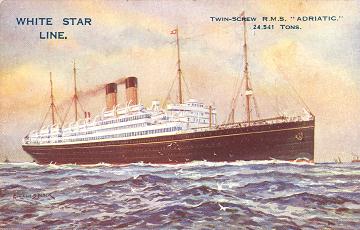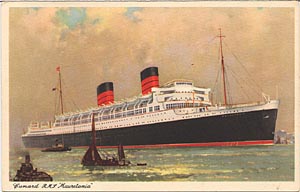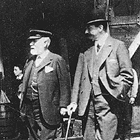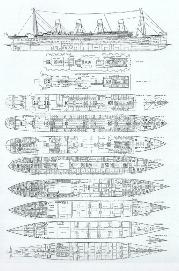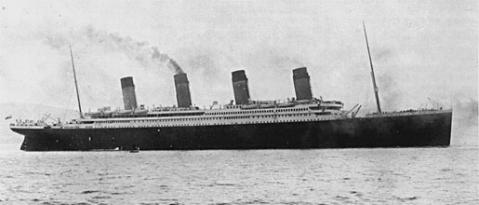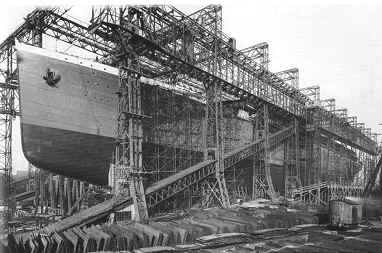
"I cannot imagine any condition which would caused a modern ship to founder ...... Shipbuilding has gone beyond that…."
|
Introduction |
|
On Thursday 20th September 1906 the White Star Line launched the Adriatic. She was the last of the four huge liners that the company commissioned. The builders, Harland & Wolff of Belfast, had a long-standing connection with the White Star Line. The Celtic was the first of the ships to be launched in April 1901. It was followed by the slightly larger Cedric in August 1902. All four ships were over 20,000 tonnes. They were built in accordance with the White Star Line's policy of providing comfort and reliability to the passengers who travelled on them. However, speed was an important factor for any sea going vessel. A high proportion of the space onboard ships was taken by large quantities of coal needed to power the ship. Thomas Ismay realised that people would make longer journeys if the vessel they were sailing on was spacious and well appointed with all the comforts of home they left behind. It was anticipated that the new ships would be very popular and in June 1905 the Baltic, a new 23, 884 ton vessel was launched. The Baltic entered service with the claim of the title "the largest ship in the world". The scale of this liner had never been seen before. Her appointments were the finest. They included the first ever swimming pool and Turkish Baths (saunas). Unfortunately, at 16.5 knots, speed was somewhat slower than preferred. Competition was already beginning with the rival company Cunard Line. They launched two ships, the Mauretania and the Lusitania.
The Mauretania (above) was launched at the Tyneside shipyard of Swan Hunters and entered service in September 1907. The Lusitania was launched at the John Brown shipyard on the Clyde and entered service in June 1907. Each weighed over 30,000 tonnes. A new generation of ships had been born which out classed the four large White Star line vessels. On her second crossing of the Atlantic, the Lusitania took the Atlantic Speed Record for Britain averaging a speed of 23.99 knots, nearly seven knots quicker than the Adriatic. To make matters worse for the White Star Line, the Mauretania also proved to be faster. The Cunard Lines had out stripped the White Star Line of owning the fastest and largest ships in the world. It was obvious to the White Star Line that their competitors were winning the struggle to maintain dominance over the Atlantic crossings. They had to react to the situation quickly. The story of the RMS Titanic and sisters begins……………… How it all began The story of the Royal Mail Ship (RMS) Titanic begins over a dinner early in 1907. The Chairman of the White Star Line, J. Bruce Ismay accompanied by his wife went to dine at Downshire House, Belgrave Square in London. They met Lord Pirrie, the Chairman of Harland and Wolff Shipbuilders and his wife. The topic of conversation of dinner were the two remarkable new liners Lusitania and Mauritania, both from the rival company Cunard lines. Ismay raised the concept of bigger and more luxurious ships, in order to surpass the existing competition. Ismay was the son of Thomas Ismay, the founder of the White Star Line. J. Bruce Isamy became President of the International Mercantile Marine Company (IMM). His long-term goal for the company was to attain the "Blue Riband" which to do so would require expensive and often uncomfortable vessels to achieve the high speed needed. Lord Pirrie had become Chairman of Harland and Wolff in 1896. Due to the nature of the industry, Harland and Wolff and the White Star Line had a close association.
After dinner, Ismay and Bruce discussed the construction of three sister ships: the Titanic, Olympic and Gigantic. It was only after the tragic loss of the Titanic that the name Gigantic was changed to Britannic. The Olympic and the Titanic would be nearly one and a half time larger than Mauretania and the Lusitania. As a result, these three ships would make the White Star Line again prominent. Rough drawings were made of the three ships which envisaged three funnelled ships each with two or three masts. The final plans added a forth "dummy funnel" for ventilation but the ships would only have two masts. The chosen names ascribed the three ships as being mighty, powerful: the biggest the world had ever seen.
Whilst safety, Luxury and comfort were the essential features throughout the plans, all three would have to be capable of significant speed. It was Bruce Ismay's job to secure finances. Early in 1908 the White Star Line issued £2,500,000 of additional shares to cover the bulk of the projected £3 million costs. Together with the profits for the year 1909 exceeding £1 million it was only a matter of time before the project could start. By the end of July 1908, the directors of the White Star Line travelled to examine the final designs of the two ships. The 31st July was a monumental day for the White Star Line because an agreement was signed to commence construction. Whilst Ismay and Pirrie had conceived the idea of the three giants, the general responsibility of the design was delegated to Alexander Montgomery Carlisle, General Manager at Harland & Wolff and Lord Pirrie's brother-in-law. Lord Pirrie approached the shipbuilders of John Brown for the supply of steel and to secure the use of new turbine technologies far more advanced than hitherto. Ships like the Mauretania were already taking advantage of the new technologies and had achieved incredible speeds. The Olympic and Titanic would have to be faster to attain the "Blue Riband". A deal was struck. Pirrie could now compare the different types of engines with new ships especially the new twin screw liners Laurentic and Megentic . Each ship could travel up to 16 knots. Triple screw engines were needed to propel a 46,000 ton ship. The engines of the Olympic Class liners stood four decks high housed in six compartments. In all there were 29 boilers supplied by 159 furnaces generating pressures up to 215lbs per square inch. The shipbuilders were faced with another problem. Since 1853 Harland and Wolff had employed 14,000 workers to build a staggering nine ships at any one time BUT the even keels of the layer ships were small compared to the giants they were about to build. No slipways in the world could yet accommodate the Titanic and her sisters. Construction began on a giant slipway named the "Great Gantry."  It cost £100,000. Its crane was specially imported from the German Benrather Company to handle the large loads necessary to fit out the ships following their launch. The crane cost £30,000. The ships would be 882.75 feet in length, 92.5 feet wide and each have a gross tonnage of 45,000. They would be the biggest ships afloat. As construction of the Titanic and Olympic continued it was evident that the ships with an overall length of 882 feet, were too big for the River Test in Southampton. As a result, the " White Star Dock” was designed specially to berth the new ships. Its construction was completed before the launch of the Olympic. It covered 16 acres and was 40 foot deep at low tide, meaning that the ships could be berthed at either low or high tide.
|
